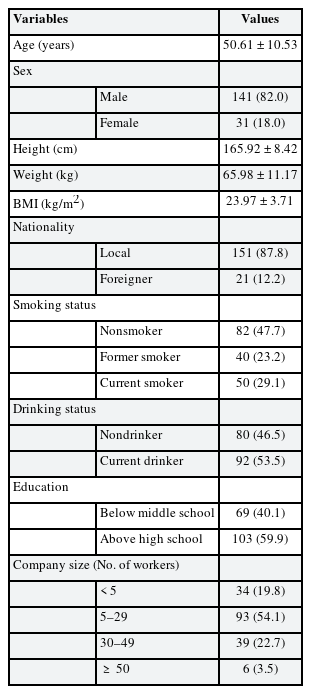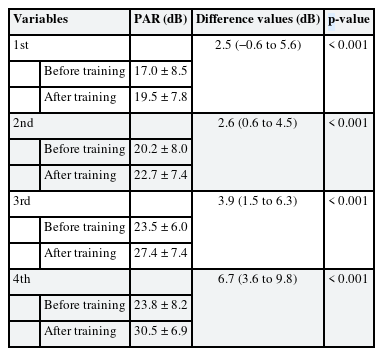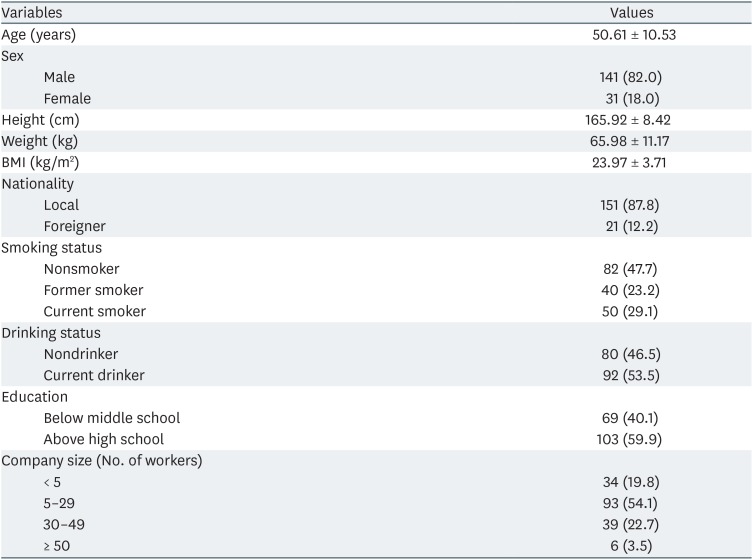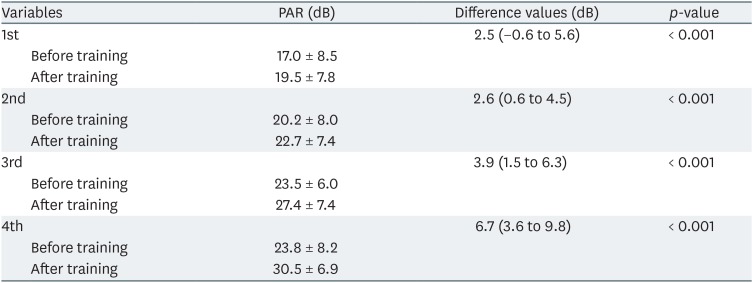The effect of earplug training on noise protection
Article information
Abstract
Background
Noise-induced hearing loss is an occupational disease, and workplace noise exposure is a major hazard in Korea. Although hearing protectors effectively reduce a worker's exposure to noise, their success is compromised by the wearer's inability to fit the protectors correctly, and there are no proper training methods for using hearing protectors in small-scale industries. This study aims to evaluate the effect of earplug training on hearing protection using field microphone-in-real-ear (F-MIRE) and prevent noise-induced hearing loss.
Methods
The study population comprised 172 noise-exposed manufacturing workers who visited occupational health facilities in Daegu, South Korea, between July 2014 and September 2017. Personal attenuation ratings (PARs) were calculated with F-MIRE. Paired t-tests were used to compare the differences in PAR (dB) before and after training, and generalized estimating equations (GEEs) were used to compare the differences in PAR according to the number of trainings.
Results
Mean PARs increased after the first and second training, and the differences were statistically significant. Among the 30 participants who received all 4 trainings, PARs were significantly higher after each training than before the training. As the number of training increased, the differences in PARs significantly increased. When comparing pretraining PARs for each training session, we found statistically significant differences between the first and second training and between the second and third training, but not between the third and fourth training.
Conclusion
In this study, the short- and long-term effects of earplug training were statistically significant. In particular, the PAR before and after the fourth training showed the greatest increase, and the PARs continued to increase during each training.
BACKGROUND
Noise-induced hearing loss is an occupational disease, and workplace noise exposure is a major workplace hazard in Korea [1234]. In a 2015 sample survey, 76,216 of the 179,168 total workplaces had noise as an exposure factor [5]. Therefore, the Korea Occupational Safety & Health Agency estimated that workers in about 42.5% of workplaces are exposed to noise. Although noise-induced hearing loss can be prevented, the condition is on the rise and is the second most common occupational illness in Korea [6]. According to the Korea Ministry of Employment and Labor, noise-induced hearing loss cases numbered 1,051 of 3,054 occupational illnesses in 2017 [7].
The best method for dealing with noise is eliminating the hazard. However, hearing protectors remain the only feasible and useful way to address the problem when engineering or administrative controls cannot eliminate noise. Although hearing protectors effectively reduce a worker's noise exposure, their performance is hampered by the user's inability to fit them correctly [8]. Moreover, there is no proper training method for using them in small-scale industries—workplaces with fewer than 50 full-time workers—based on the Occupational Safety and Health Act [9]. Earplugs have higher laboratory-tested noise reduction ratings (NRRs) than earmuffs do because the former creates an effective seal at the ear canal and lacks interference with hair, headgear, and head shape [101112]. However, a literature review reported that earplugs were more likely to perform poorly under real-world conditions, relative to their NRR, due to inadequate use [1314]. In a study by Berger et al. [15], laboratory attenuations typically were equivalent to or greater than field attenuations.
Earplug training is important for achieving the performance level published by the manufacturer. Murphy et al. [16] demonstrated a 10–20 dB improvement in attenuations when subjects were provided ear protector training. Joseph et al. [17] demonstrated an 11 dB improvement in attenuations after training. For this reason, it is important to train workers on the proper method of using earplugs for preventing noise-induced hearing loss.
Hence, the goal of this study is to evaluate the effect of earplug training using field microphone-in-real-ear (F-MIRE) and prevent noise-induced hearing loss.
METHODS
The study population comprised 172 noise-exposed manufacturing workers who visited occupational health facilities in Daegu, South Korea, from July 2014 to September 2017. Of the participants, 172 subjects had training twice, and 30 had training four times. Attenuations were calculated using F-MIRE. One embodiment of the F-MIRE approach is 3M's E-A-Rfit™ Dual-Ear Validation System (3M, St. Paul, MN, USA), which is evaluated in this report. The principle of the device is to calculate the attenuations of an individual by measuring the noise inside and outside the earplug using a microphone for 10 seconds after sounds of 150–8,000 Hz in frequency are produced [18]. This method can check the attenuations of each wearer quickly and precisely, and objectively show changes in attenuations according to the wearing method. The result of this method is represented by personal attenuation ratings (PARs). PARs are calculated in a manner similar to the Noise Reduction Statistic for use with A weighting (NRSA), but it does not include the 3-dB spectral safety factor and a subtractive 2-standard-deviation correction. The unit of PAR is dB. The larger the dB value, the lower the noise exposure.
PARs were measured in an office, where the level of background noise is low, to prevent equipment error. Once the participants were situated in the office, they were asked to select an earplug similar to the one used in their workplaces. Three earplugs were selected for this study: E-A-R Classic® foam earplugs, E-A-Rsoft™ FX™ earplugs, and E-Z-Fit™ (all product from 3M). After choosing the earplugs, the subjects wore them in the usual way. The noise was produced, and PAR (dB) were measured for both ears. Earplug training was then carried out, and the PAR of both ears were measured again. According to the manual of the F-MIRE, the smaller PAR was used as the result.
Earplug training was conducted once a year. As part of the training, pictures were taken of the participants wearing earplugs before training and then again after a training session, during which the subjects were told the problems with how they wore earplugs and instructed on how to use them. Workers were shown the PAR on the computer and instructed that earplugs should not be visible when the wearer looks straight into the mirror. Training took about 5 minutes per person, and measurement took about 10 minutes per person.
We used paired t-tests to compare the differences in PAR before and after training, and generalized estimating equations (GEEs) to compare the differences in PAR according to the number of trainings. Age, sex, nationality, and education were included as adjustment variables. By comparing the differences in PAR before and after each training, this study showed a one-time training short-term effect, and by comparing PAR before each training, this study showed the effect over time, or long-term effect. A p-value less than 0.05 was considered statistically significant. SAS syntax: PROC GENMOD and SAS ver. 9.4 were used in all statistical analyses (SAS Institute, Cary, NC, USA). This study was approved by the Institutional Review Board (IRB) of Keimyung University Hospital (IRB No. 2019-03-039).
RESULTS
Table 1 shows the general characteristics of the subjects, which were collected before first training began. There were 141 (82.0%) men and 31 (18.0%) women. The age of the subjects ranged from 22 to 74 years, and the mean age was 51. In terms of education, 69 (40.1%) subjects did not graduate from middle school, and 103 (59.9%) subjects received higher than a high school education. Of the participants, 151 (87.8%) were native Koreans, and 21 (12.2%) were foreigners. In addition, 166 (96.5%) subjects worked at workplaces with fewer than 50 full-time workers. Table 2 shows the mean PAR before and after the first and second training. The mean improvements were 4.7 dB after the first training and 5.2 dB after the second training. The improvements were statistically significant (p < 0.001). Using generalized estimating equations to compare the 4 PARs, we found a statistically significant effect over time (p < 0.001). Table 3 shows the average PAR before each training. The mean improvement was 2.8 dB, which was statistically significant (p < 0.001).
Table 4 shows the average PAR before and after each of the four trainings. The mean improvement in PARs was statistically significant (p < 0.001) for all the trainings. For the 30 subjects who had all four trainings, PARs were statistically significantly higher after each training compared with before the training. As the number of trainings increased, the difference in PAR significantly increased. When comparing the 8 PARs in generalized estimating equations, we found a statistically significant (p < 0.001) effect over time. The mean PAR before each training were 17.00 dB for the first, 20.17 dB for the second, 23.47 dB for the third, and 23.83 dB for the fourth. When comparing pretraining PAR for each training session, we found statistically significant differences between the first and second training and between the second and third training, but not between the third and fourth training (Table 5).
DISCUSSION
This study was designed to show the effect of earplug training through a comparison of PAR. It demonstrated the effect of earplug training on the noise exposure of workers. As shown in Tables 2 and 4, the differences in PAR after each training show the statistically significant short-term effects of earplug training. According to our results, the short-term effect of the fourth training was the largest. Therefore, the greater the number of trainings, the bigger the effect.
When the PAR before each training were compared, the differences in PAR showed statistically significant long-term effects for all earplug training except for before the third and fourth training, as shown in Tables 3 and 5. While there was no statistically significant difference in PAR before the third and fourth training, PAR increased by 0.3 dB. These results show that earplug training is effective in reducing noise exposure and that PAR increases more with repeated trainings.
Murphy et al. [19] also demonstrated that poorly performing subjects were able to insert earplugs properly and achieve sufficient attenuation after training. That study used videos for earplug training, which produced the same performance as printed instruction. These results corroborated those of the present study and from Joseph et al. In a study by Hager [20], earplug training via fit-testing systems enabled workers to use earplugs effectively and motivated noise-exposed workers. Earplugs are essential for preventing noise exposure, but supervisors must appreciate that earplug training is absolutely necessary.
The present study has several limitations. First, the study population consisted of a small sample from one area, so it is difficult to generalize the findings to all manufacturing workers. Second, there is no control group, so the reliability is not very high. For the next study on this topic, we suggest that a control group be selected to increase the reliability of the study.
CONCLUSIONS
In this study, the short- and long-term effects of earplug training were statistically significant. In particular, the PAR before and after the fourth training showed the greatest increase, and the PAR continued to increase during each training.
Finally, we emphasize the importance of earplug training for better PAR. In a future study, it will be necessary to study the effect of training through longer-term follow-up by using a control group for more samples.
Notes
Competing interests: The authors declare that they have no competing interests.
Authors contributions:
Conceptualization: Kim JW, Yang S.
Data curation: Yang S, Chung I, Kim JW.
Formal analysis: Lee MY, Kim JW.
Investigation: Kim JW, Yang S, Lee MY.
Writing - original draft: Kim JW.
Writing - review & editing: Lee MY.
Abbreviations
F-MIRE
field microphone-in-real-ear
GEE
generalized estimating equation
NRR
noise reduction rating
NRSA
Noise Reduction Statistic for use with A weighting
PAR
personal attenuation rating










